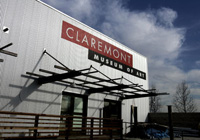 Claremont Museum of Art forages for money
Claremont Museum of Art forages for moneyBy Suzanne Muchnic, Los Angeles Times Staff Writer
September 24, 2008
THE ART OF MONEY: Claremont Museum of Art faces budget challenges despite a recent donation of $10 million from an anonymous patron.Despite $10-million donation, the fledgling institution's gift will trickle in at about $250,000 a year, so brain trust huddles to examine fundraising methods.
A $10-million gift to almost any art museum is not taken lightly. That kind of money can fund a new gallery, art acquisitions, staff positions or educational programs. But when a tiny upstart, such as the Claremont Museum of Art, gets a $10-million windfall, it isn't merely an enhancement. It's a ticket to transformation. And shock.
"This has put us on the map," said William Moreno, the museum's director. "That's the short-term effect. A vote of confidence from a donor at that level is pretty important. In the longer term, it affords us some time to do the planning."
Housed in a historic, former fruit packing plant, the Claremont fledgling that calls itself "a regional museum of international significance and breadth" has established itself with a lively program of contemporary art exhibitions and related events.
But what's a 15-month-old museum with a 7,400-square-foot space and four full-time staff members to do with all that money?
That seemed to be the question last July, when the museum announced its very nice problem: a $10-million donation from an anonymous patron identified only as "a longtime resident of Southern California."
The answer is more complicated than it might seem because the museum has received a deferred gift.
The bulk of the money will arrive in the form of annuities, trusts and real estate after the donor's death. Until then, the museum will reap about $250,000 a year in income from those investments.
The immediate challenge, museum leaders say, is not to figure out how to use a multimillion-dollar gift wisely but to chart a course for a bigger and better future.
With a marketing program nearly complete, the museum recently staged a "community dialogue" to help shape a strategic plan to be finalized by the end of the year and allowed a Times reporter to sit in. About three dozen museum supporters, civic and business leaders, educators and arts professionals clustered around small tables and pooled ideas.
But first came some facts.
Frank Chabre, the museum's board president, told the group that the museum operated on about $850,000 to $900,000, a bit less than the projected $1 million, during its first full year. But the hoped-for $3-million endowment? "Zip. We don't have it," he said. Then he delivered more bad news: "We have a cash flow problem . . . We need a reserve for slower times."
Janet Myhre, a retired professor of mathematics and economics at Claremont McKenna College, said the museum didn't have the resources it needed to grow. She set out new financial targets: an annual operating budget of $1.2 million to $2 million and an endowment of $10 million to $12 million, which would produce enough income to cover half the expenses.
Director of development Evonne Gallardo explained that the museum needed a track record of raising funds to get help from foundations and asked everyone in the room to become an ambassador. "Friend-raising," she said, "can become fundraising."
When the brainstorming began, small groups batted around possible ways to build the museum's base of support, raise its profile and bring in cash.
Among the ideas: Rent the museum space to outside groups for special events, organize tours of art collectors' homes, sponsor student art competitions and auctions, collaborate with other museums on fund-raising events, host appraisal clinics, cultivate the retirement community as well the young, reach out to service clubs, encourage corporate sponsorship of exhibitions and publications.
"We really are living hand-to-mouth like everyone else," Dr. Joe Unis, a radiologist who heads a foundation dedicated to furniture maker Sam Ma- loof, said when it came time to share ideas, which were hastily scribbled on a large white pad by a member of each group.
But this is one museum with a pot of gold at the end of its rainbow.
No one, including John D. Maguire, president emeritus of Claremont Graduate University and advisor to the museum's board of trustees, denies that the gift comes with responsibilities.
"The big issues," he said, "are continuing the flow of operating funds; space -- at what rate and how to expand; and broadening the base of regional support. But the bottom line is, having had a chance to be present at the creation, I am enormously pleased with where we have managed to get in 17 months. We are on our way."
suzanne.muchnic @latimes.com
 Claremont Museum of Art forages for money
Claremont Museum of Art forages for money